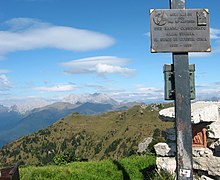| Carnic Alps | |
|---|---|
| Alps Cjargnelis (Friulian) Karnische Alpen (German) Alpi Carniche (Italian) Karnijske Alpe (Slovene) | |
 View from Pfannspitze along the main ridge to the east. | |
| Highest point | |
| Peak | Coglians |
| Elevation | 2,782 m (9,127 ft) |
| Coordinates | 46°36′N 12°53′E / 46.600°N 12.883°E |
| Geography | |
| Countries | Austria and Italy |
| Länder, Regioni | Tyrol, Carinthia, Friuli-Venezia Giulia and Veneto |
| Range coordinates | 46°30′N 13°00′E / 46.500°N 13.000°E |
| Parent range | Southern Limestone Alps |
| Geology | |
| Orogeny | Alpine orogeny |
The Carnic Alps (Italian: Alpi Carniche; German: Karnische Alpen; Slovene: Karnijske Alpe; Friulian: Alps Cjargnelis) are a range of the Southern Limestone Alps in Austria and northeastern Italy. They are within Austrian East Tyrol and Carinthia, and Italian Friuli (Province of Udine) and marginally in Veneto.
Etymology
[edit]They are named after the Roman province of Carnia, which probably has a Celtic origin.
The mountains gave their name to the stage on the geologic time scale known as Carnian, an age in the Triassic Period.
Geography
[edit]They extend from east to west for about 100 km (62 mi) between the Gail River, a tributary of the Drava and the Tagliamento, forming the border between Austria and Italy.
Alpine Club classification
[edit]The Carnic Alps are divided into two distinct areas:
|
In the Carnic Alps is the southernmost glacier in Austria, the Eiskar, nestling in the Kellerwand massif.
Notable peaks
[edit]
Among the most important mountains of the range are:
- Coglians / Hohe Warte (2,782 m)
- Kellerspitzen (2,774 m)
- Monte Peralba / Hochweißstein (2,694 m)
- Monte Cavallino / Große Kinigat (2,689 m)
- Rosskopf (2,603 m)
- Monte Terza Grande (2,586 m)
- Monte Bìvera (2,474 m)
- Creta Forata (2,462 m)
- Helm (2,434 m)
- Cresta di Enghe (2,414 m)
- Monte Ferro (2,348 m)
- Gailtaler Polinik (2,332 m)
- Trogkofel (2,280 m)
- Monte Sernio (2,187 m)
Mountain passes
[edit]
The chief passes of the Carnic Alps are:
- Plöcken Pass (Tolmezzo to Kötschach-Mauthen), road (1,360 m)
- Naßfeld Pass (Pontebba to Hermagor-Pressegger See), road (1,552 m)
- Öfnerjoch (Forni Avoltri to Sankt Lorenzen im Lesachtal), footpath (2,301 m)
- Wolayer Pass (same to Kötschach-Mauthen), footpath (1,922 m)
Well, that’s interesting to know that Psilotum nudum are known as whisk ferns. Psilotum nudum is the commoner species of the two. While the P. flaccidum is a rare species and is found in the tropical islands. Both the species are usually epiphytic in habit and grow upon tree ferns. These species may also be terrestrial and grow in humus or in the crevices of the rocks.
View the detailed Guide of Psilotum nudum: Detailed Study Of Psilotum Nudum (Whisk Fern), Classification, Anatomy, Reproduction